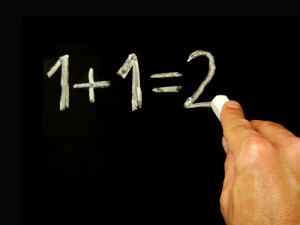Estimation: How to Accelerate the Learning Process with Math and Build Visualization and Conceptual Skills Simultaneously
by Robert J. Doman Jr.
 Teaching your child how to use estimation in math can significantly improve his learning curve. Estimation can increase the rate at which your child learns math facts, improve math conceptual development, and increase the overall intensity, and therefore impact, of math instruction. Estimation also provides a means for assessing his knowledge of math facts, as well as his understanding of math concepts. If your child is unable to make an estimation with a specific math function or operation, such as with fractions, then he probably does not understand the concept. Estimation is valuable for every child, whether learning single digit addition or calculus. Estimation is also a valuable tool for the development of visualization and conceptualization skills.
Teaching your child how to use estimation in math can significantly improve his learning curve. Estimation can increase the rate at which your child learns math facts, improve math conceptual development, and increase the overall intensity, and therefore impact, of math instruction. Estimation also provides a means for assessing his knowledge of math facts, as well as his understanding of math concepts. If your child is unable to make an estimation with a specific math function or operation, such as with fractions, then he probably does not understand the concept. Estimation is valuable for every child, whether learning single digit addition or calculus. Estimation is also a valuable tool for the development of visualization and conceptualization skills.
The process of teaching your child to estimate involves plenty of input and feedback. Before a child does a math problem, ask her, “What do you think the answer is going to be?” Have her estimate the answer and write that number above the problem. After she has completed the problem, discus how close she came with the estimation and how she might have approached it differently or better.
If your child is just beginning basic addition or subtraction, permit him to do whatever he likes, including using his fingers at first; but very quickly discourage the use of his fingers, and have him attempt to do the estimation mentally. After he has estimated the answer, have him calculate the problem in the normal way. After calculating the answer, then he should compare it to his estimation. If the answer is the same as the estimation, congratulate him or, if necessary, reward him with tokens or some other reinforcement. If he was close, give your child appropriate feedback, such as, “Well done, you were really close. I bet next time you can get it.” Feel free to cue him with such things as, “I think you know this one. Remember, two plus three is……” If it is a simple problem that he could know as a fact, encourage him to remember the fact. When you are comfortable that he has learned a fact, and his estimation is consistently correct, reward him by telling him that he got it correct and does not need to go through the process of calculating the answer. If his estimation is way off, encourage him to really think about the answer and not just guess. You can also teach your child to do such things as rounding. You do not want to provide this level of feedback and input on every problem. Be discerning and use it when you feel it is appropriate. But encourage him to use estimation on every problem, with the exception of very new processes that you are just introducing.
An important lesson often not learned well by students is that math makes sense; it is not just an unintelligible series of steps or procedures. The process of creating an estimation helps math make sense.
In order for your child mentally to go through the estimation process, he will either need merely to access a math fact (if he is doing basic arithmetic), or use visualization (thinking in pictures) or conceptualization (thinking in words). As your child develops estimation skills, he is learning when and how to apply the most effective and efficient tool for the situation, as well as how to move back and forth between visualization and conceptualization with ease. For instance let’s take an example that involves rounding. To add 298 and 403 in an efficient way using this process (certainly not the only way) you could think the following: 298 is almost 300 (conceptualization), and 403 is just a little more than 400 (conceptualization); so 300 plus 400 is 700 (visualization). 700 would be a good estimation, but if processing is high enough, you can take it another step: 298 is only two less than 300 (conceptualization), and 403 is three more than 400 (conceptualization). Three minus two is one (visualization or conceptualization), so the actual answer is 701. To help you understand these applications, go through the example and try visualizing when conceptualization was indicated and vice versa. It can certainly be done, but for most people it would be more difficult. Your personal strengths and weaknesses and sequential processing skills generally determine how you approach such problems. If you were unable to go through the process at all, please give our office a call, order Simply Smarter, and have someone get you on our evaluation schedule.
In terms of applying math to real-life situations, estimation becomes critical because you are often dealing with situations where you do not need actual answers nor have the means to get the actual answer. For example, if you are walking into a grocery store with $50 in your pocket and are buying groceries for a family of four, you had better be able to estimate or else face serious embarrassment when you get to the checkout with a full cart and insufficient funds.
As someone who is responsible for operating an organization, I am acutely aware of how easily a bookkeeper or accountant can miss-enter a number or put a decimal in the wrong place. When your child is working on higher-level math and using a calculator, he easily can make the same mistakes, and if he has not estimated the answer, he is going to miss unnecessary errors. Such errors can be significant if they were to occur during a major exam or on an SAT test. If I were unable to look at the big picture, get the concept, and estimate, many serious errors would go unnoticed.
Teaching your child to use estimation can make the difference between a bored poor math student and an excited superior math student. It can also help produce those rare anomalies: children who love math and by extension, love such amazing things as physics. But of even greater importance, estimation teaches your child not only how to think, but to think. We always need more people who can think.





